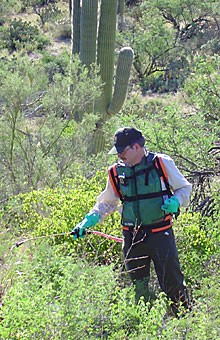UA students are working with Saguaro National Park officials to eradicate buffelgrass, an invasive non-native plant, a park official said.
The plant, originally brought to the Tucson area from Africa to feed grazing cattle and provide erosion control in mining areas, poses a threat to the Sonoran Desert, said Meg Weesner, chief of sciences and resource management at Saguaro National Park.
Weesner said the plant increases fuel for wildfires and robs native species of water and space.
“”Buffelgrass is a prolific seeder,”” she said. “”Its seed is viable for three to four years.””
That factor – combined with the seed’s windborne travel – makes it difficult to get rid of, as single stands take several years to eradicate.
Workers in Saguaro National Park exterminate buffelgrass by spraying it with a glyphosate herbicide, sold commercially as Roundup, or by pulling it up by the root, Weesner said.
She said that timing is crucial when it comes to killing buffelgrass. Extermination must be carried out in August, after monsoon rain has allowed the buffelgrass to flourish and before the plants have a chance to spread their seed.
Moreover, herbicides are only effective when the plants are healthy and green, because the poison is absorbed through the leaves, said Perry Grissom, a Saguaro National Park fire ecologist.
Kris Ratzlaff, a UA graduate with a bachelor’s degree in natural resources emphasizing
UA students have been really instrumental in buffelgrass eradication and research.
-Meg Weesner
chief of sciences and resource management at Saguaro National Park
on wildlife science, works on buffelgrass eradication in Saguaro National Park. Ratzlaff said that she and other workers are spraying the same areas another group treated last year and will continue to use herbicide to kill buffelgrass until there are no more green plants.
When bufflegrass is not green, it can be removed by the root, she said.
Laura Bassaraba, a biology senior who works on the spraying team, said the grass is more hazardous than people may think.
“”It’s a major source of fire,”” she said. “”That’s something people should be aware of. It burns a lot of land.””
Weesner said buffelgrass fires are most often caused by ignition from tossed cigarette butts and lightning.
Many Tucsonans have no idea that buffelgrass grows in their own backyard or may think it’s a native plant that isn’t harming the environment, Ratzlaff said.
Homeowners who think they have buffelgrass growing on their property should contact experts, Weesner said.
There are many programs that train and educate volunteers to recognize and eradicate buffelgrass, she added.
Weesner said student groups and volunteers have done a great job participating in the removal.
“”UA students have been really instrumental in buffelgrass eradication and research,”” she said.









